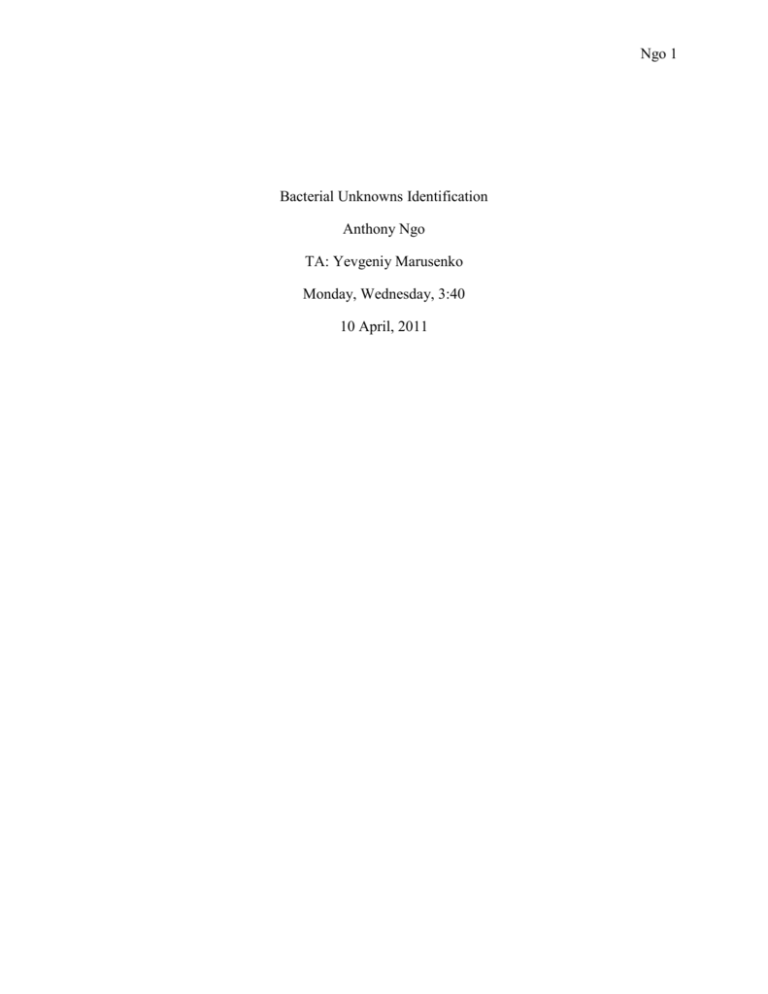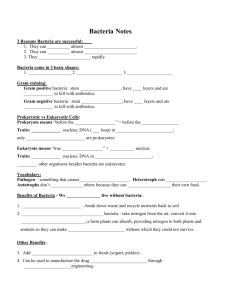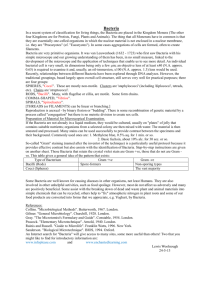File
advertisement

Ngo 1 Bacterial Unknowns Identification Anthony Ngo TA: Yevgeniy Marusenko Monday, Wednesday, 3:40 10 April, 2011 Ngo 2 Abstract In this project, a broth that contained a mixture of two unknown bacteria was given. The objective of the experiment was to isolate the two different bacteria from the mixture, grow them in pure culture, and perform several specific tests to identify the two bacteria. In order to isolate the bacteria, the streak plate was used. Many other methods that helped identify the bacteria were used. These included the gram stain, endospore stain, motility test, the catalase test, nitrate reduction test, coagulase test, IMViC, and several others. After all of these tests were performed, the identity of the two bacteria was determined. One of the bacteria was found to be the gram positive coccus Kocuria Rosea. The other bacteria was identified as Serratia liquefaciens. Introduction A mixture contains two or more organisms. To determine the identity of these organisms, they must first be isolated. This can be done by using the streak plate. Steven Woeste who is an assistant professor in the Department of Basic Biomedical Sciences, Schull College of Podiatric Medicine, believes that the plate streak is important and that “To master the technique is to be able to produce pure cultures on demand, and it is the foundation of modern microbiology. (4) The isolated bacteria can then be grown in pure cultures using the Mac and CNA plates. The CNA plate inhibits the growth of gram negative bacteria and the Mac plate inhibits the growth of gram positive bacteria. With the availability of many tests that determine the properties and characteristics of bacteria, the identities of the bacteria can be observed. Thus, if a mixture of two bacteria can be isolated, grown in culture and their properties observed, then the identities of the two bacteria can be determined. Ngo 3 Materials and Methods In order to properly conduct all of the experiments and tests for this project, several materials were required. In addition to all of the materials mentioned in each of the required sections from the lab manual, a Bunsen burner, several inoculating loops, a striker, test tubes, and a test tube rack were necessary. The procedures from the sections from the lab manual Microbiology Labaratory Theory & Application by Michael J. Leboffe were used to perform the experiments. To isolate the mixture of organisms, section 1.4 Streak Plate Methods of Isolation was used. The organisms were grown in pure culture and other methods were used to help identify them. The procedures for these were sections 3.9 Capsule stain, 3.10 Endospore stain, 2.7 Fluid thioglycollate medium, and 5.20 SIM medium. Lastly, the tests from the flow charts 713 from section 7.7 and 7-17 from section 7.8 were used to identify the gram negative and gram positive bacteria respectively (3). All tests were performed aseptically. Results This table shows the results for the early tests that were performed to help identify the unknown bacteria Gram staining Endospore staining Capsule staining Fluid Thioglycollate Medium (FTM) SIM test Gram + Coccus Absence of endospores Absence of capsules Strict anaerobe Gram Rod Absence of endospores Absence of capsules Facultative anaerobe No motility Some motility is observed, sulfur is produced The results show that gram staining both the gram positive and gram negative bacteria led to no results. After the endospore and capsule staining were performed, it was determined that both the gram positive and gram negative bacteria lacked endospores and capsules. The FTM test Ngo 4 for gram positive was determined to be a strict anaerobe. For gram negative, the result was a facultative anaerobe. The SIM test resulted in no motility for the gram positive bacteria and some motility and sulfur production for the gram negative bacteria. Gram Positive Cocci Glucose Oxidation-Fermentation Test Oxidation Fermentation Nitrate Reduction + Coagulase Tube Test - - + Nitrate Reduction + Kocuria rosea Micrococcus luteus - Staphylococcus aureus Staphylococcus epidermidis Staphylococcus saprophyticus Flow chart for identification of gram positive cocci. Red arrows indicate path followed. To determine the identity of the gram positive bacteria, the above flow chart was used from the lab manual. The glucose oxidation-fermentation test was performed, which resulted in green and yellow colors. This indicated the presence of oxidation. The nitrate was reduction was then tested, which ended with a positive result. Thus, the identity of the gram positive bacteria was K. rosea. Ngo 5 Gram Negative IMViC (Indole/Methyl red/Voges-Proskauer/Citrate) - + + + Sucrose Fermentation + - Gelatinase Urease - + - + Xylose fermentation - + Klebsiella pneumoniae Hafnia alvei Serratia marcescens Proteus mirabilis Serratia liquefaciens Flow chart for identification of gram negative bacteria. Red arrows indicate path followed. In order to determine the unknown negative bacteria, the first test performed was the IMViC test. This test consisted of the indole, methyl red, voges-proskauer and citric tests. The results for these tests were negative, positive, positive, and positive respectively and thus, led to the use of the flow chart 7-13 from section 7.8 from the lab manual. The sucrose fermentation test was then performed and had positive results. The gelatinase and xylose fermentation tests also had positive results. Thus, the identity of the gram negative bacteria was determined to be S. liquefaciens. Ngo 6 Discussion Following the flow chart, the identities of the two bacteria were determined. The gram negative bacteria was identified as S. liquefaciens and the gram positive bacteria was K. rosea. The results from the gram staining test were difficult to read. However, the gram negative bacteria was rod shaped and the gram positive bacteria was coccus. These results comply with the actual shapes of the bacteria. Furthermore, S. liquefaciens are facultative anaerobes and are motile and these characteristics match with the results from the FTM and SIM tests. K. rosea are not motile and the SIM test performed also confirms this. K. rosea are found in freshwater, and soilwater. Additionally, they may cause infections in patients who have a low immune system. In patients with catheter infections and where K. rosea are unresponsive to medical treatment, patients must be treated by catheter removal (1) S. liquefaciens can cause infections in the iatrogenic bloodstream (2). They can also infect the respiratory tract within humans and they are naturally found in water reservoirs. Thus, these bacteria can have great impacts on human lives and this is why it is important to study them and to be able to identify and observe them. Ngo 7 Works Cited 1. Altuntas, F. 2004. Catheter-related bacteremia due to Kocuria rosea in a patient undergoing peripheral blood stem cell transplantation. BMC Infectious Diseases. 4:62. 2. Chuang,T. Aortic valve infective endocarditis caused by Serratia liquefaciens. Journal of Infection. 54:161-163. 3. Leboffe, M.J. Pierce, B.E. Microbiology Laboratory Theory & Application. Morton Publishing Company. 4. Woeste ,S. 2011. A Template for the Streak Plate Isolation Technique for Laboratory Classrooms. Journal of Biological Education.30:1







